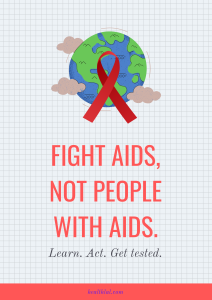HIV vs. AIDS: What is the difference?
HIV and AIDS are often used interchangeably, but they are not the same thing. Understanding the difference between the two is crucial for awareness, prevention, and treatment. In this blog, we’ll explore what HIV and AIDS are, how they are related, and the key distinctions between them
History of HIV and AIDS
HIV was first identified in the early 1980s when doctors noticed a rise in rare infections among otherwise healthy individuals. By 1983, researchers had isolated the virus responsible for weakening the immune system. Over the decades, scientific advancements have improved diagnosis, treatment, and prevention. Today, thanks to antiretroviral therapy (ART), people with HIV can lead long and healthy lives, and efforts continue to develop a vaccine.
What is HIV?
HIV (Human Immunodeficiency Virus) is a virus that attacks the body’s immune system, specifically targeting CD4 cells (T cells), which help fight infections. If left untreated, HIV reduces the number of these cells, making it harder for the body to fight off infections and diseases.
HIV is transmitted through:
-
- Unprotected sexual contact
- Sharing needles or syringes
- Mother-to-child transmission during birth or breastfeeding
- Blood transfusions (rare due to modern screening methods)
Stages of HIV:
- Acute HIV Infection – This occurs within 2 to 4 weeks after exposure, often accompanied by flu-like symptoms.
- Chronic HIV Infection – Also known as the asymptomatic stage, where the virus remains active but reproduces at low levels.
- AIDS (Acquired Immunodeficiency Syndrome) – The most severe stage of HIV infection.
What is AIDS?

AIDS (Acquired Immunodeficiency Syndrome) is the advanced stage of HIV infection. It is diagnosed when the immune system is severely damaged, leading to opportunistic infections and certain cancers. A person with AIDS has a CD4 count below 200 cells per cubic millimeter of blood (compared to a normal range of 500-1,500) or has developed specific serious illnesses.
Without treatment, AIDS significantly shortens life expectancy, but with modern antiretroviral therapy (ART), people with HIV can live long and healthy lives without progressing to AIDS.
Key Differences Between HIV and AIDS
| Factor | HIV | AIDS |
|---|---|---|
| Definition | A virus that weakens the immune system | The final stage of HIV infection |
| Immune System Impact | Gradually weakens the immune system | Severe immune system damage |
| Symptoms | Often mild or flu-like in early stages | Serious infections and illnesses due to immune failure |
| Treatment | Managed with antiretroviral therapy (ART) | ART can help manage but not cure AIDS |
| Life Expectancy | Long with treatment | Shorter if untreated, but manageable with ART |
Comparison of HIV Transmission Methods
| Transmission Method | Risk of HIV Transmission |
|---|---|
| Unprotected sexual contact | High |
| Sharing needles | High |
| Mother-to-child (birth/breastfeeding) | Moderate to High |
| Blood transfusions | Very Low (due to modern screening) |
| Casual contact (hugging, shaking hands) | None |
| Sharing food or drinks | None |
| Mosquito bites | None |
Can HIV Be Treated?
Yes! Although there is no cure for HIV, antiretroviral therapy (ART) can effectively control the virus, allowing individuals to live healthy lives. Early detection and consistent treatment prevent the progression to AIDS. Moreover, people on ART with an undetectable viral load cannot transmit HIV to their partners (Undetectable = Untransmittable, or U=U).
Prevention of HIV
Preventing HIV involves a combination of behavioral, medical, and structural interventions:
| Prevention Method | Effectiveness |
|---|---|
| Safe sex practices (condoms) | High |
| Pre-Exposure Prophylaxis (PrEP) | Very High |
| Post-Exposure Prophylaxis (PEP) | High if taken within 72 hours |
| Regular HIV testing | Prevents unknowingly spreading HIV |
| Needle exchange programs | Reduces risk for drug users |
| Male circumcision | Reduces risk for heterosexual men |
| Education and awareness | Reduces stigma and misinformation |
Conclusion
HIV and AIDS are closely related, but they are not the same. HIV is the virus that, if left untreated, can lead to AIDS, which is a severe, life-threatening condition. The good news is that with early diagnosis, proper medical care, and lifestyle adjustments, individuals with HIV can prevent the progression to AIDS and lead fulfilling lives.
Raising awareness and promoting preventive measures are crucial in the fight against HIV/AIDS. If you believe you may be at risk, getting tested and seeking medical advice can make all the difference.
Stay informed. Get tested. Stay safe.
Frequently Asked Questions (FAQs)
1. Can you get HIV from kissing? No, HIV is not transmitted through saliva. It spreads through blood, semen, vaginal fluids, rectal fluids, and breast milk.
2. How long can someone live with HIV? With proper treatment, people with HIV can live nearly as long as those without the virus.
3. Is there a cure for HIV? Currently, there is no cure for HIV, but antiretroviral therapy (ART) effectively manages the virus.
4. Can HIV-positive individuals have children? Yes, with proper medical care and treatment, HIV-positive individuals can have healthy, HIV-negative children.
5. How soon after exposure can HIV be detected? HIV can be detected within 10 to 90 days after exposure, depending on the test used.
6. Does HIV always lead to AIDS? No, with early diagnosis and consistent ART treatment, HIV can be controlled, preventing the progression to AIDS.
7. Can I get HIV from a mosquito bite? No, HIV cannot be transmitted through mosquito bites.

